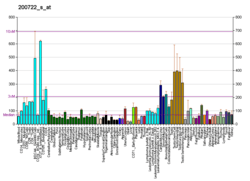Caprin-1
Caprin-1 is a protein that in humans is encoded by the CAPRIN1 gene.[5][6][7][8][9][10] It is suggested that Caprin1 (a.k.a. RNG105) is essential for the formation of long-term memory.[11]
References
- 1 2 3 GRCh38: Ensembl release 89: ENSG00000135387 - Ensembl, May 2017
- 1 2 3 GRCm38: Ensembl release 89: ENSMUSG00000027184 - Ensembl, May 2017
- ↑ "Human PubMed Reference:".
- ↑ "Mouse PubMed Reference:".
- ↑ Ellis JA, Luzio JP (Oct 1995). "Identification and characterization of a novel protein (p137) which transcytoses bidirectionally in Caco-2 cells". J Biol Chem. 270 (35): 20717–23. doi:10.1074/jbc.270.35.20717. PMID 7657653.
- ↑ Wang B, David MD, Schrader JW (Sep 2005). "Absence of caprin-1 results in defects in cellular proliferation". J Immunol. 175 (7): 4274–82. doi:10.4049/jimmunol.175.7.4274. PMID 16177067.
- ↑ Solomon S, Xu Y, Wang B, David MD, Schubert P, Kennedy D, Schrader JW (Feb 2007). "Distinct Structural Features ofCaprin-1 Mediate Its Interaction with G3BP-1 and Its Induction of Phosphorylation of Eukaryotic Translation Initiation Factor 2α, Entry to Cytoplasmic Stress Granules, and Selective Interaction with a Subset of mRNAs". Mol Cell Biol. 27 (6): 2324–42. doi:10.1128/MCB.02300-06. PMC 1820512. PMID 17210633.
- ↑ Grill B, Wilson GM, Zhang KX, Wang B, Doyonnas R, Quadroni M, Schrader JW (Feb 2004). "Activation/division of lymphocytes results in increased levels of cytoplasmic activation/proliferation-associated protein-1: prototype of a new family of proteins". J Immunol. 172 (4): 2389–400. doi:10.4049/jimmunol.172.4.2389. PMID 14764709.
- ↑ Katsafanas GC, Moss B (Dec 2004). "Vaccinia virus intermediate stage transcription is complemented by Ras-GTPase-activating protein SH3 domain-binding protein (G3BP) and cytoplasmic activation/proliferation-associated protein (p137) individually or as a heterodimer". J Biol Chem. 279 (50): 52210–7. doi:10.1074/jbc.M411033200. PMID 15471883.
- ↑ "Entrez Gene: GPIAP1 GPI-anchored membrane protein 1".
- ↑ https://elifesciences.org/articles/29677
Further reading
- Gessler M, Klamt B, Tsaoussidou S, et al. (1996). "The gene encoding the GPI-anchored membrane protein p137GPI (M11S1) maps to human chromosome 11p13 and is highly conserved in the mouse". Genomics. 32 (1): 169–70. doi:10.1006/geno.1996.0099. PMID 8786113.
- de Vries H, Rüegsegger U, Hübner W, et al. (2000). "Human pre-mRNA cleavage factor IIm contains homologs of yeast proteins and bridges two other cleavage factors". EMBO J. 19 (21): 5895–904. doi:10.1093/emboj/19.21.5895. PMC 305781. PMID 11060040.
- Strausberg RL, Feingold EA, Grouse LH, et al. (2003). "Generation and initial analysis of more than 15,000 full-length human and mouse cDNA sequences". Proc. Natl. Acad. Sci. U.S.A. 99 (26): 16899–903. doi:10.1073/pnas.242603899. PMC 139241. PMID 12477932.
- Rual JF, Venkatesan K, Hao T, et al. (2005). "Towards a proteome-scale map of the human protein-protein interaction network". Nature. 437 (7062): 1173–8. doi:10.1038/nature04209. PMID 16189514.
- Ewing RM, Chu P, Elisma F, et al. (2007). "Large-scale mapping of human protein–protein interactions by mass spectrometry". Mol. Syst. Biol. 3 (1): 89. doi:10.1038/msb4100134. PMC 1847948. PMID 17353931.
This article is issued from
Wikipedia.
The text is licensed under Creative Commons - Attribution - Sharealike.
Additional terms may apply for the media files.





